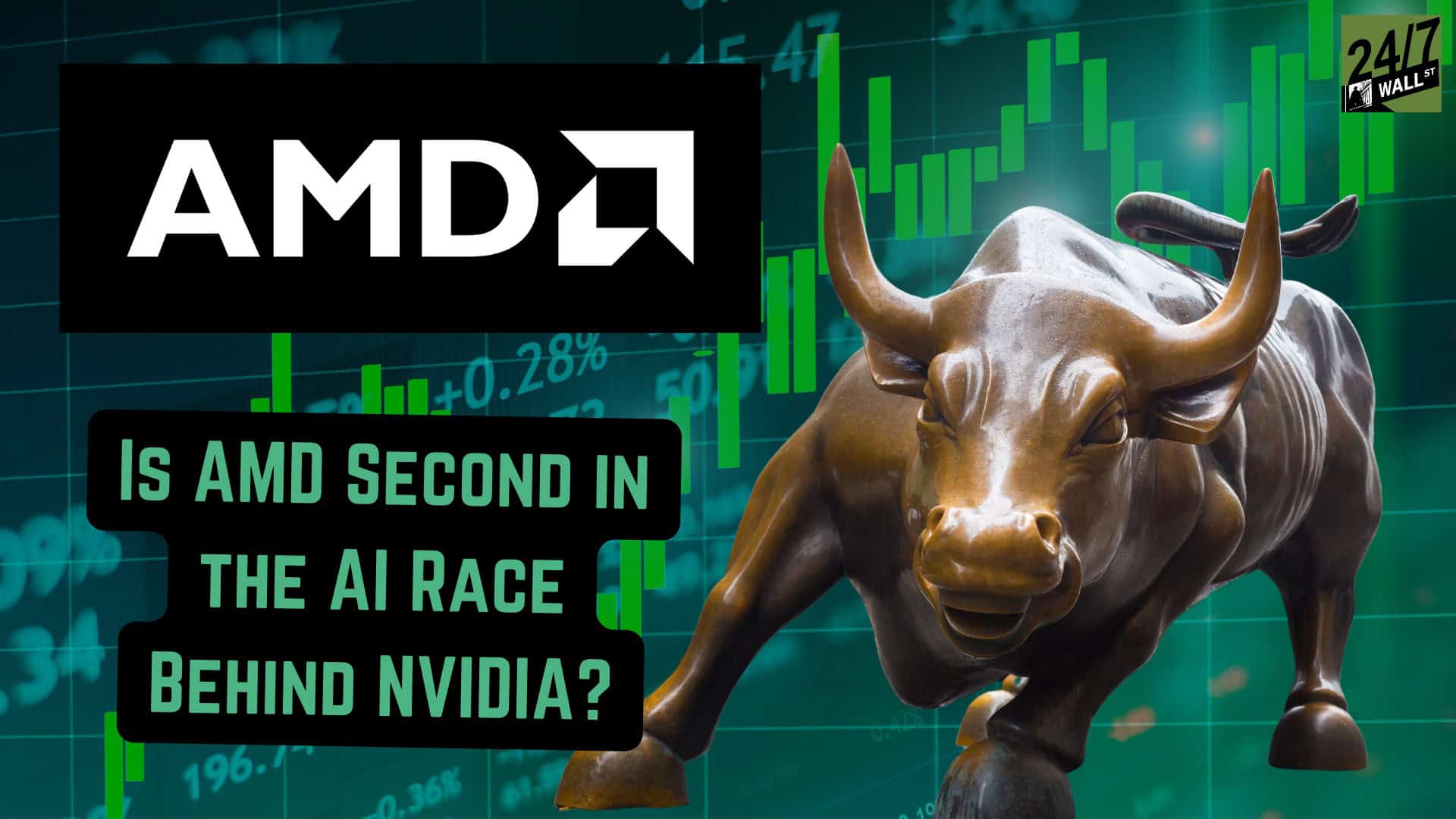
The two most popular stocks AI investors look to are NVIDIA (NASDAQ: NVDA) and AMD (NASDAQ: AMD). It’s largely assumed that while NVIDIA is the market leader, AMD is second place in the race for AI chip supremacy. Yet, are there options investors are ignoring in the space that could be even closer on NVIDIA’s heels than AMD? We break down how close AMD’s AI chip sales come to NVIDIA and a potential third option in the space that should be on investor’s radars.
Is AMD Second Behind NVIDIA in AI Chips?
Wall Street 24/7 Analysts Eric Bleeker and Austin Smith discuss the battle for AI chip supremacy above. You can also find a summary of the discussion below:
- AMD is the second-most recognizable name when it comes to AI processor sales.
- The reason is they’ve long competed with NVIDIA in the GPU space. They’re a leader in chips that have the right design for AI workloads. For that reason, AMD has often been seen as the “Pepsi” to NVIDIA’s market-leading “Coke.”
- However, it’s important to compare just how the relative market positions of the two companies look. The gap between the two is probably larger than most investors realize.
- If we’re looking at growth rates in their most recent quarters.
- NVIDIA reported 262% sales growth
- Wall Street expects AMD to report 7% sales growth when it next reports earnings.
- If we’re looking at operating profit, NVIDIA’s rose 690% last quarter
- And estimates for AMD now stand at 17%
- The divergence in these growth rates may be surprising, but there are a few important reasons.
- First, NVIDIA’s Data Center segment reported a run rate of $90 billion in sales last quarter. With the expectation of growth continuing throughout the year, NVIDIA should book more than $100 billion in Data Center (AI-related) sales
- Compare that to AMD, which last updated guidance that it now expects to sell $3.5 Billion worth of its MI300 AI chips in 2024. It’s anticipated AMD will surpass that number, but this does show the current gap between NVIDIA and AMD revenues in AI sales.
- So, why is AMD so far behind?
- One reason is that NVIDIA’s Data Center group also includes networking sales. The company has previously reported that networking sales are at a $13 billion run rate. NVIDIA’s networking alone is roughly 4X the size of AMD’s total AI chip sales.
- So, now that we have the perspective of size difference between NVIDIA and AMD in mind. What’s a contender that might be closer in size to NVIDIA in the AI market?
- Broadcom (NASDAQ: AVGO) is one stock you’d have to consider. The company makes custom AI accelerators for large clients and reported recently it expects $7 billion in sales from its two largest clients in 2024. Those companies are widely assumed to be Alphabet and Meta.
- With AI momentum growing, some third-party estimates have Broadcom’s AI rising above the guidance it previously issued on earnings calls. Researcher Semi Analysis believes Broadcom might sell $8.5 Billion worth of TPUs (the custom chip it designed for Alphabet) to Alphabet in 2024 alone.
- In addition, Broadcom is one of NVIDIA’s fiercest competitors for networking revenue as data centers are redesigned for the age of AI.
- The key point here is that Broadcom may be getting more than double AMD’s AI chip revenue from just a single customer, and has added on design wins. It should easily surpass $10 billion in AI sales this year.
- From a revenue perspective, Broadcom is expected to grow sales 35% in 2024. Once again, Wall Street is expecting 7% revenue growth from AMD when they next report.
- The point: If you’re an AMD investor, you’re inherently betting NVIDIA will continue losing market share in AI data centers in the years to come.
- If you’re making that bet, Broadcom may be another stock you want to add to your portfolio as they’re an alternative to the big two GPU companies and are getting significant traction in the AI space.
Transcript:
All right, Eric, we’ve talked a lot about AI this year, and we’re not done yet.
Everybody knows what the most valuable AI stock is.
It’s NVIDIA, right?
But what’s the number two?
There are so many choices out there, and I’m kind of confused.
I hear some people saying maybe Microsoft is the second most valuable AI stock, but that’s not an AI company.
I mean, they have an AI exposure through OpenAI, of course, but they’re also a gaming company and an infrastructure company and so many other things.
So what really is the second most valuable AI stock out there today?
Yeah, you know, as you mentioned right now, so much attention is on NVIDIA itself, but where people are really looking is where revenue is accruing to most tightly is the processors, right?
The companies that make GPUs and that segment.
There’s NVIDIA that’s been the clear number one, but there’s also AMD as a secondary option.
So AMD is probably the second most recognizable name when it comes to AI processor sales.
So, you know, if you were making an analogy here, I would say AMD has always been compared as the Pepsi to NVIDIA’s Coke.
Now I do want to bring up what kinds of, you know, opportunities both have relative to each other.
We look at revenue growth from last year.
In the most recent quarter, NVIDIA report 262%.
For AMD, in the quarter that they’re about to report Wall Street forecast, they will present 7% growth.
We look at operating profit, NVIDIA just report 690% growth.
Once again, these are Wall Street expectations for the coming quarter, 17%.
So one question is, what’s the reason for the gap in how these two companies are growing if they’re both GPU vendors?
Well, NVIDIA’s data center unit last quarter was at a $90 billion run rate and should easily surpass $100 billion this year.
By contrast, the big headline when AMD last reported earnings was taking up their expectations for their AI chip, the MI300, from $2 billion to $3.5 billion in pre-orders for 2024.
Now, that number should rise.
But again, we’re looking at $100 billion plus versus $3.5 billion.
What’s one of the reasons for this gap?
Well, NVIDIA, in addition to just processors, has a large networking unit that’s growing at three times year over year.
So they’re also getting a lot of networking sales.
Now, are there any other companies that combine this, you know, AI accelerators, being able to build the processors for AI workloads and also networking?
I would point investors to Broadcom, a number I want to put on investors’ radar.
It’s been reported by Semi Analysis that Broadcom could be looking at up to $8.5 billion this year in orders for their custom chip that they’re making for Google, the TPU it’s called.
That number comes from Semi Analysis and the past estimates from Broadcom itself was they had mentioned 7 billion this year, just from their two largest customers, which are Google and Meta.
So we’re seeing some probable acceleration here, but also that number, even if you take the low point of 7 billion, that is still multiples higher than AMD.
And the other side is Broadcom has a huge networking unit as well.
So they’re getting the same tailwinds, just not in processors, but also networking as well, much like NVIDIA.
So when we’re looking at AI chips alone, I believe Broadcom is likely at a minimum of about three times the size of AMD in the AI market.
And if we look at revenue growth for this year, the revenue is expected to be up 35%, which once again, we had looked at AMD’s next quarter, the expectations for that earlier at 7% revenue growth.
My point here being Broadcom isn’t nearly the household name that AMD is.
It’s not compared to NVIDIA nearly as much.
But this is a stock that if you are an AMD investor, you’re inherently betting that on NVIDIA losing some market share.
And if they are losing market share, another company that’s going to be a big recipient is likely Broadcom.
If you’re owning AMD on that thesis, I think you should really look at whether you want to add Broadcom to your portfolio as well.
Thank you for reading! Have some feedback for us?
Contact the 24/7 Wall St. editorial team.





